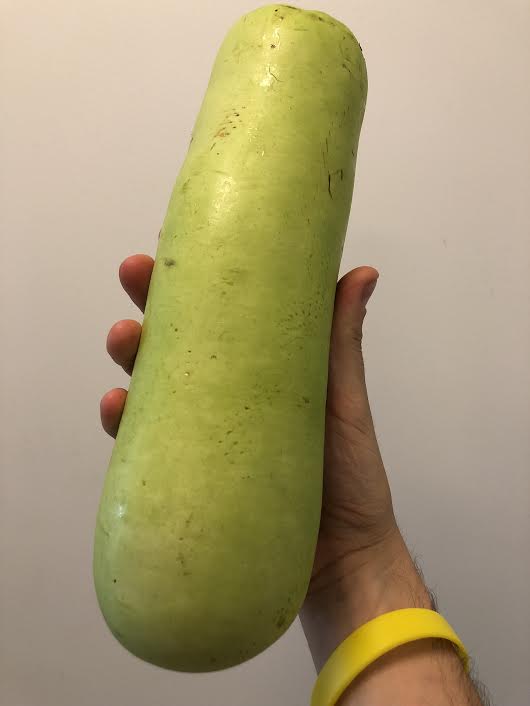
SCIENTIFIC NAME: Lagenaria siceraria. The calabash gourd is often confused with the calabash tree (genus Crescentia), which has similar fruits but is only a distant cousin. Calabash tree fruit has a long history with humans and can be used much like a true calabash, but this is a post about real gourds, so forget about it for now.
COMMON NAMES: Calabash is possibly humanity’s oldest crop, and as you’d expect, it has accumulated a ton of different names over the centuries. In English alone, calabash is also called white gourd, bottle gourd, long gourd, and New Guinea bean. South Asian grocery stores like the one where I bought mine (Patel Brothers in Queens, NY) use dudhi or lauki. English “calabash” derives from Spanish calabaza, a word of uncertain origin.
[Side note: “calabash” is one of my favorite English words. Not because of the fruit, necessarily; I just love the sound of it. Maybe I just like its resemblance to Caliban, one of my favorite Shakespeare characters. Maybe it’s the forcefulness of the final syllable, how the repeated vowel unrolls like a magic word: Abracadabra. Alakazam. Calabash.]
ORIGIN: The importance of calabash to human beings is twofold: the young fruits are edible, but the dried outer shell of the mature fruit makes an excellent watertight container. Calabash fruits may reach several feet in length and are variously skinny or bottle-shaped, straight or twisty, contributing to their variety of uses. Because of this, calabash has been cultivated by people for so long that we’re not even sure precisely where it comes from. Like another universally useful organism–the dog–there was likely more than one domestication of the calabash in Paleolithic times. People appear to have been using the plant in Asia from around 11,000 years ago and in the Americas from around 10,000 years ago.
How calabash got from one continent to another, and on which continent it started, remains something of a mystery. Some think the gourds floated across the oceans like coconuts, but calabash may simply have been so important that our earliest ancestors carried it with them everywhere they went as they dispersed around the world. In ancient times it was known to everyone from the Romans to the Chinese to the Taíno of the Caribbean, whose partly-submerged hunters wore calabash masks to sneak up on waterfowl. Medieval Europeans considered cucurbita (calabash) one of the plants of an ideal garden. Centuries later, enslaved people in the Americas planted calabash in their own gardens as a supplement to their meagre rations. A calabash was the “drinking gourd” of the famous Follow the Drinking Gourd song, said to have led the way to freedom via the Underground Railroad.
To this day, calabash has a place in the cuisines and cultures of just about every part of the world. In parts of South America, calabash is used to make the traditional container for the caffeinated beverage mate. In West Africa, dried calabashes are made into water containers, musical instruments, and makeshift motorcycle helmets. In Japan, thinly-sliced dried calabash strips called kanpyō (かんぴょう) are used in some sushi rolls, or as an edible wrapping to tie ingredients together. There’s almost nothing a calabash can’t do.
FUN FACTS:
- In Italian-American slang, googootz (dialect for calabash or zucchini) can be used as an insult to mean a stupid or useless person. Ironic, given how useful calabashes actually are.
- There’s a long tradition in the United States, started by Native Americans, of making dried calabashes into birdhouses. These were hung in crop fields to attract the purple martin, a swallow-like bird that feeds on insects, as a form of natural pest control. John James Audobon commemorated the practice with a painting of martins nesting in a gourd.
- The city of Calabasas, California, home of the Kardashians and various other celebrities, takes its name from Spanish calabazas. Popular legend attributes the name to a 19th-century wagonload of pumpkins that spilled on the future site of the city, causing hundreds of vines to sprout the following spring. Calabasas still holds an annual Pumpkin Festival in celebration. [Note that as in many languages, calabaza can be a generic term for any large gourd species.]
FLAVOR: The white flesh of the calabash is mild and sweet, though not as sweet as pumpkin or butternut squash, and watery, but not as much as a cucumber or snake gourd. Calabash holds up well to cooking (though perhaps not roasting) and is particularly good for stir-fries and soups. I shredded one with other veggies for the Korean noodle dish japchae at my book release party a while back. But I could just as easily have breaded it, made it into curry, etc, etc. With its incredible millennia-long history of use by humans, calabash is in some ways the archetypal, OG gourd. If you’ve got a calabash on your hands, you’re bound to find a recipe, whatever your favorite cuisine.

They do look pretty serpentine, but these gourds are calabash (Lagenaria), not the Trichosanthes species more commonly known as snake gourd. Confusing moments like these are the reason scientific nomenclature exists. Photo by Jim the Photographer (2012) via Flickr.





You must be logged in to post a comment.